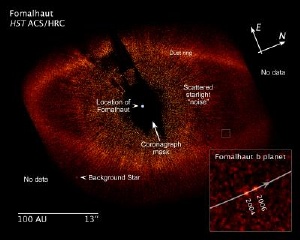Nov 13 2008
NASA's Hubble Space Telescope has taken the first visible-light snapshot of a planet circling another star. Estimated to be no more than three times Jupiter's mass, the planet, called Fomalhaut b, orbits the bright southern star Fomalhaut, located 25 light-years away in the constellation Piscis Australis, or the "Southern Fish."
 This visible-light image from the Hubble shows the newly discovered planet, Fomalhaut b, orbiting its parent star. Credit: NASA, ESA, P. Kalas, J. Graham, E. Chiang, and E. Kite (University of California, Berkeley), M. Clampin (NASA Goddard Space Flight Center, Greenbelt, Md.), M. Fitzgerald (Lawrence Livermore National Laboratory, Livermore, Calif.), and K. Stapelfeldt and J. Krist (NASA Jet Propulsion Laboratory, Pasadena, Calif.)
This visible-light image from the Hubble shows the newly discovered planet, Fomalhaut b, orbiting its parent star. Credit: NASA, ESA, P. Kalas, J. Graham, E. Chiang, and E. Kite (University of California, Berkeley), M. Clampin (NASA Goddard Space Flight Center, Greenbelt, Md.), M. Fitzgerald (Lawrence Livermore National Laboratory, Livermore, Calif.), and K. Stapelfeldt and J. Krist (NASA Jet Propulsion Laboratory, Pasadena, Calif.)
Fomalhaut has been a candidate for planet hunting ever since an excess of dust was discovered around the star in the early 1980s by NASA's Infrared Astronomy Satellite, IRAS.
In 2004, the coronagraph in the High Resolution Camera on Hubble's Advanced Camera for Surveys produced the first-ever resolved visible-light image of the region around Fomalhaut. It clearly showed a ring of protoplanetary debris approximately 21.5 billion miles across and having a sharp inner edge.
This large debris disk is similar to the Kuiper Belt, which encircles the solar system and contains a range of icy bodies from dust grains to objects the size of dwarf planets, such as Pluto.
Hubble astronomer Paul Kalas, of the University of California at Berkeley, and team members proposed in 2005 that the ring was being gravitationally modified by a planet lying between the star and the ring's inner edge.
Circumstantial evidence came from Hubble's confirmation that the ring is offset from the center of the star. The sharp inner edge of the ring is also consistent with the presence of a planet that gravitationally "shepherds" ring particles. Independent researchers have subsequently reached similar conclusions.
Now, Hubble has actually photographed a point source of light lying 1.8 billion miles inside the ring's inner edge. The results are being reported in the November 14 issue of Science magazine.
"Our Hubble observations were incredibly demanding. Fomalhaut b is 1 billion times fainter than the star. We began this program in 2001, and our persistence finally paid off," Kalas says.
"Fomalhaut is the gift that keeps on giving. Following the unexpected discovery of its dust ring, we have now found an exoplanet at a location suggested by analysis of the dust ring's shape. The lesson for exoplanet hunters is 'follow the dust,'" said team member Mark Clampin of NASA's Goddard Space Flight Center in Greenbelt, Md.
Observations taken 21 months apart by Hubble's Advanced Camera for Surveys' coronagraph show that the object is moving along a path around the star, and is therefore gravitationally bound to it. The planet is 10.7 billion miles from the star, or about 10 times the distance of the planet Saturn from our sun.
The planet is brighter than expected for an object of three Jupiter masses. One possibility is that it has a Saturn-like ring of ice and dust reflecting starlight. The ring might eventually coalesce to form moons. The ring's estimated size is comparable to the region around Jupiter and its four largest orbiting satellites.
Kalas and his team first used Hubble to photograph Fomalhaut in 2004, and made the unexpected discovery of its debris disk, which scatters Fomalhaut's starlight. At the time they noted a few bright sources in the image as planet candidates. A follow-up image in 2006 showed that one of the objects is moving through space with Fomalhaut but changed position relative to the ring since the 2004 exposure. The amount of displacement between the two exposures corresponds to an 872-year-long orbit as calculated from Kepler's laws of planetary motion.
If the object is in a true orbit, then it is in the same plane as the disk. The amount of displacement between the two exposures is exactly as predicted and corresponds to an 872-year-long orbit as calculated from Kepler's laws of planetary motion.
Future observations will attempt to see the planet in infrared light and will look for evidence of water vapor clouds in the atmosphere. This would yield clues to the evolution of a comparatively newborn 100-million-year-old planet. Astrometric measurements of the planet's orbit will provide enough precision to yield an accurate mass.